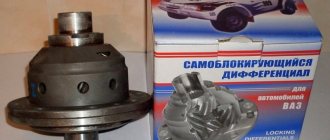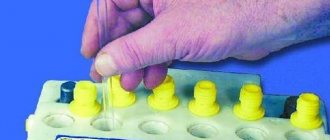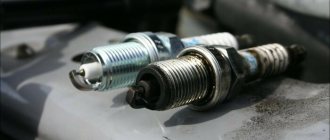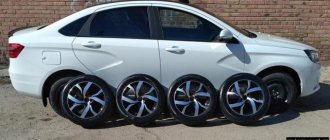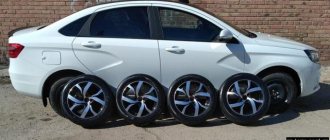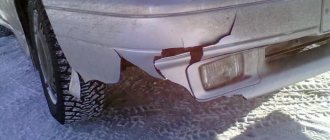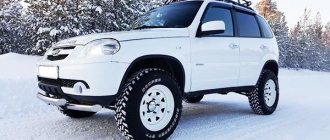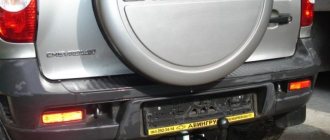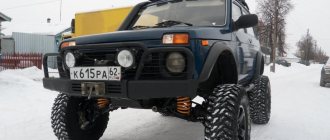A differential is a device designed specifically to transmit the so-called torque from a car engine to its wheels using transmission elements. A free differential, installed on vehicles during assembly at the factory, cannot affect the other when one of the wheels slips. Differential locking can help achieve different wheel speeds when necessary (for example, on poor, usually dirt roads). It increases torque on one of the wheels, usually the one with the best traction. To achieve this result, a self-locking differential is used. An alternative option could be a forced blocking method. It is important to understand whether it is worth installing a self-locking differential on the Niva, what this will do for the car and how to carry out the installation of the device.
Is it worth installing a self-locking differential on a Niva?
A differential is a device designed specifically to transmit the so-called torque from a car engine to its wheels using transmission elements. A free differential, installed on vehicles during assembly at the factory, cannot affect the other when one of the wheels slips. Differential locking can help achieve different wheel speeds when necessary (for example, on poor, usually dirt roads). It increases torque on one of the wheels, usually the one with the best traction. To achieve this result, a self-locking differential is used. An alternative option could be a forced blocking method. It is important to understand whether it is worth installing a self-locking differential on the Niva, what this will do for the car and how to carry out the installation of the device.
Rear and front differential lock
There are two types of blocking: Full blocking can be carried out either manually or automatically. Partial – only automatically.
Such a system can be implemented using the following parts:
- helical gears.
- friction discs;
The disadvantages include the following factors: The automatic locking system has its own nuances, in particular the need to customize it to the driver’s individual driving style.
But the following advantages of this type of differential lock are also noted: But it is worth noting the presence of disadvantages of such a system. These include excess noise on the road when cornering, as well as the presence of a certain click every time the lock is activated. To get started you will need the following tools:
- adjusting rings of different diameters;
- measuring tool for car.
Why do you need a self-block for Niva?
The presence of all-wheel drive in a car does not always give it the status of an all-terrain vehicle. Sometimes, due to the nature of their design, vehicles designed for off-road driving can become trapped on washed out roads. A self-locking differential is an important component of the car if the driver plans to use his Niva to drive on bad roads.
What is a self-block, or limited slip differential? This is a device that ensures wheel locking, and automatically, at the right time. It is an intermediate option between a full lock and a free differential. The self-block combines the capabilities of both of these devices.
Niva and differential lock
- front and rear axles (interwheel), ensuring rotation of the drive wheels on the same axis at different speeds when one of them slips;
- central (interaxial), distributing torque from the engine between the front and rear axles.
- when driving on paved roads, the differential lock must be disabled;
- on steep climbs and weak soils, you should engage a low range of gears in PK;
- when crossing difficult areas of the terrain, you should turn on the blocking in advance;
- It is necessary to switch PK to a lower range of gears only after the car has completely stopped;
- You can switch to a lower gear and turn on the lock while driving the car at any speed, having first disengaged the clutch;
- For normal operation of the locking drive, it is recommended to periodically (once a week) switch the lever to PK, especially in winter.
To ensure the safety of children when driving in cars, special means are often used in the form of car seats, boosters or special seat belts. What means are allowed by traffic rules and what can a driver be fined for?
Timely and competent flushing of the cooling system is the key to efficient engine operation.
Some tips on how to properly clean the cooling system externally and internally.
Types of mechanisms
There are two main types of self-locking differentials, which include several more subtypes. The first type is devices that lock depending on the angular velocities on the vehicle axles. They can be:
The second type is mechanisms that lock depending on the torques on the axes. These include worm differentials.
There are also center and cross-axle differentials. They involve the distribution of torque between the axles and wheels, respectively. Depending on the moment of distribution attributable to the axles or wheels, symmetrical and asymmetrical types of mechanisms are distinguished. On vehicles called all-wheel drive, three types of differentials are installed at once: two of them are interwheel, and one is interaxle.
On the Niva it is possible to install electronic, mechanical (it is a conventional mechanism combined with a viscous coupling), and pneumatic differentials.
The electronic self-block has a very big advantage. To use it, just press a button. It works in automatic mode, but only when the car is traveling at a certain speed, which is below a threshold value. The system turns off when the speed exceeds the set speed.
The pneumatic differential is a mechanism mounted on two axles. The advantage is compactness. In its work it uses pneumatic systems.
The mechanical self-block is the simplest in its design; it is cheaper than pneumatic and electronic devices. The mechanism consists of two semi-axial and two spacer couplings, pins and springs. Quite a reliable design, despite its simplicity.
What is a differential?
Since the advent of the automobile, the issue of moving in a circle has been resolved by engineers for a long time. As a result, such a familiar device as the differential was invented. Briefly, the essence of its work can be conveyed as follows: when passing sections with different path lengths, the internal wheels travel a shorter distance than the external ones due to a change in the force in the gearbox. However, when driving on a road with a low coefficient of adhesion, it may turn out that the slipping wheel will not allow another, albeit driven, wheel to rotate. It is possible to overcome such sections by engaging all-wheel drive, but the road dirt is often stronger.
The differential is needed for optimal distribution of torque when cornering and maneuvering, when the wheels begin to spin at different angular speeds.
Where is the differential located:
• on a rear-wheel drive car in the axle housing, and combined with the final drive gear;
• on front-wheel drive, also combined with the main gear and, as a rule, in the same housing with the gearbox; • on all-wheel drive vehicles they are present both in the front and rear, and are combined with the main gears; • also, in all-wheel drive SUVs and crossovers, for optimal distribution of torque to all wheels, a third differential is added and installed between the axles in the transfer case. Those differentials that operate on the drive wheels are called inter-axle
, and differentials that distribute moments between the axles of the car are called
inter-axle
.
The operating principle of the differential is based on the idea of a planetary gearbox. Depending on the type of gear used, differentials are of the following types: cylindrical, bevel, worm. The bevel differential is usually used in cross-axle differentials. Cylindrical is common, due to its design simplicity, in center differentials. The worm gear is recognized as universal and the quietest in operation, although it is the most difficult to manufacture; it is used in both inter-wheel and inter-axle drives. To improve cross-country ability, differentials with locking capabilities are introduced into the transmission. The center differential will allow you to connect the wheels of one of the drive axles as needed and at the discretion of the driver. But when driving on difficult roads, it is not always possible to track when entering impassable areas; this is where self-locking differentials (or self-locking differentials)
. Their internal parts transmit increased forces to the axle shaft, depending on the radial loads on the wheels.
Types of self-blocks on Niva
➤ automatic differential Krasikov (DAK) and Nesterov (DAN). Named after the names of the inventors, they are actually devices known as limited slip differentials. The role of the transmission link in them is played by chains of balls that move uniformly inside the cage and effectively block the axle shaft. Due to the original design, it has a fairly low price, but at the same time, such products have a short service life (about 40,000 kilometers), there are flaws in the design of the body, and features appear in driving the car. ➤ self-locking differential from Val-Racing. They were created at a subsidiary of AvtoVAZ and are worm-type differentials. The transmission link is a worm gear. Since this differential is developed at the factory, its service life is much longer, it has a larger range of workloads, but does not cope well with its work in areas with low traction.
Worm-type limited slip differentials This system provides automatic locking. Operation depends on the difference in torque between the housing and the drive shaft. If a wheel slips and torque drops, the worm differential will lock and torque will be redirected to whichever wheel is available. These designs are more popular.
Characteristics and selection rules
The choice of a self-locking differential is determined by the car model, its operating conditions, driving style and many other parameters. For example, a ball differential increases steering load, which actually changes the driving style of whoever is behind the wheel. This is mainly felt when making U-turns and turns, but can lead to breakdowns of transmission components.
If you approach the choice of a self-block correctly, then you need to take into account which axle of the car the mechanism will be installed on, since the number of splines for different models is different - twenty-two or twenty-four.
The marking on the device packaging will tell you whether it can be used for a given car brand. The blocking coefficient also varies: for example, 0.5 or 0.7. These numbers show the amount of torque transmitted. What to choose is up to the driver.
How to install a self-block?
A self-locking differential is an independent product that is installed in place of the standard one. You can perform this procedure either independently or at a car service center. This is a matter of personal choice, if you have the skill and understanding of how everything works, then you can do it yourself. I installed a self-block at a car service center, and a similar procedure four years ago cost me five grand.
In this case, the determining factor was the need to make the necessary adjustments, set the required gaps, use special stands and other subtleties that I do not know. In any case, after installing the correct self-block (more on this below), no problems arose during its operation.
DIY self-block installation instructions
To install a self-locking differential on a Niva, it is not necessary to contact a car service center. It is quite possible to do this with your own hands, provided that the person has a good understanding of the structure of the car. The type of differential and its installation location are not particularly important.
First you need to decide on the place where the work will be done; it should be spacious enough. Using several jacks, you will need to lift the Niva, dismantle the wheels, then drain the engine oil from the gearbox housing into some container and remove the drive axle drive. To do this, just use a spanner to unscrew all the nuts securing the front cover to the gearbox housing, remove the cover and gasket.
Now it is necessary to reliably and efficiently carry out the operation of dismantling the axle shafts, which is very difficult to do without a special puller. The metal is clamped on rotary slots, which requires a lot of effort, which not every person has enough. Dismantling the axle shafts is carried out as follows:
Then you need to change the bearings. This will require a hydraulic press. It will help ensure that the holder fits onto the shaft, and with fairly high accuracy. To replace you need:
After the clearances in the main gear are adjusted using special washers of variable thickness, you can begin assembling the unit. Adjusting the gaps is quite difficult, and you will need special equipment, but to ensure accuracy you can use a steelyard. To work with it, wind one end of a 1 m long cord around the flange and secure the other end to the scales. By pulling the device in the winding, you will need to record the turning moment.
To ensure proper operation of the gearbox, the parts are usually sealed before the halves are assembled. In its absence, malfunctions may occur during operation, as well as failure of certain spare parts. After applying the sealant, you need to wait a while for it to harden. Then new oil should be poured into the gear housing. All sealing joints that were damaged during dismantling, as well as those that show signs of oil leakage, must be completely replaced with new ones. Now you can start assembling all the mechanisms in reverse order.
After completing all the replacement and installation of parts, you must check the operation of the devices that provide vehicle braking. Their malfunction may affect road safety.
The feasibility of such an action as differential locking on a Niva depends on why the driver needs it. If you need to move through difficult areas, you will need it. If a car enthusiast intends to drive on a normal asphalt road, then installing a self-locking differential on the Niva is hardly worth it. Which self-block to choose and where to place it depends on the driver’s preferences.
Source
My review of Dak and Racing
It just so happened that I had to use the two mentioned types of self-blocks. Their price at the time of purchase was almost the same - ten thousand, the installation is also the same, but the result is completely different.
If the DAK failed after about six months, and not in intensive use, but when driving on ordinary forest roads, then the Togliatti one (val racing) is still working.
Maybe I was just unlucky, but I have repeatedly come across reports that there are problems with the quality of the metal in the production of DAKs. So think for yourself.
There are a huge number of opinions about whether a self-block is needed at all, and the most polar ones - from “why is it needed” to “is absolutely necessary.” As always, the choice is a personal matter and everyone must make it themselves.
Again, I will only express my opinion.
It seems to me that everything depends on how and where you move in your car. If you go to the country or mostly on asphalt, then you definitely don’t need a self-block.
The situation is approximately the same if your hobby is off-roading and you are engaged in conquering impassable roads. Here, such “half measures” as self-locking will not work and here you need a full manual differential lock.
Self-locking differential on Niva: is it worth installing?
Niva car is a type of off-road vehicle. This car is designed for driving on not the best sections of the road, off-road.
What is a limited slip differential?
A self-locking differential is a device based on a screw design. Increases the cross-country ability of vehicles, in particular such as Niva. When installing a differential, the car can easily overcome difficult sections of the road and terrain where driving is difficult. Therefore, installing a “self-block” on a Niva increases and improves the capabilities of this machine.
Center lock
There are devices that are designed only for off-road vehicles. They are not installed on cars for normal city driving. One of these “helpers” is the Center Differential. It distributes movement across axes. Its purpose is to transfer the rotating movement of one source to others . That is, if the rear or front wheels slip and the car cannot move, then the driving dynamics are distributed to all wheels. The operation of the center lock is based on a simple principle - the torque (rotation of the wheels) is divided between the front and rear axles . This effect makes it possible for the car to continue moving. Agree that this is a very good invention for cars - SUVs, which also includes the Niva.
Single axle locking – cross-axle
Cross-wheel locking of one axle is another function of a self-locking differential. To drive through difficult terrain, axle locking will undoubtedly be necessary. But often this is not enough. And there is a need to increase the power of the machine. It is in this case that you need to use inter-wheel locking of one axle.
The axle lock can be forced by the driver.
It can also be automatic. When one of the wheels slips
, the locking function is activated.
The principle of operation is the transmission of rotational motion exactly where the load is least .
If the “self-block” is installed on the front axle, it is possible to enable inter-wheel locking. If on the rear axle, then on the rear axle there is the same possibility. Interaxle locking switches movement from the front axle to the rear and vice versa, and interwheel locking transfers torque between the wheels on a certain axle . The inter-wheel locking can automatically turn on itself, if necessary. During normal driving, the differential operates in classic mode.
The question arises,
on which axle is it more advisable to install a self-locking differential
, on the front or on the rear?
Motorists have differing opinions on this. Some recommend the rear axle, others vice versa. If you are afraid of getting stuck on the road or problem area, especially due to adverse weather conditions, you can install a “self-block” on the front and rear axles . This will give you confidence, and if the car gets into a difficult section of the road, all wheels will work perfectly!
What types of self-locking differentials are there for the Niva?
A self-locking differential can be selected for any make of car. They are available for both domestic and foreign cars.
If we objectively characterize the types and principles of operation of differentials, then they can be divided into three types :
1. Locking differential
, which will turn on and occur when the movement accelerates.
2. Self-locking differential
, which functions when braking and accelerating the car.
3. Something in between the first and second types. When slowing down, there will be a smoother operating process.
Also defining names: gerotor differential, differential that is sensitive to the difference in rotational torques of movement, friction differential.
Perhaps, of these three types, the least desirable is friction . Why is it not as good as other types? Inside it, friction discs are located on the axle shafts. Fuel consumption when using it increases slightly, and the service life of the friction discs is short. Among the manufacturing companies that manufacture these devices, there are both foreign and domestic manufacturers. The choice depends on your preferences, car brand and characteristics.
Advantages and disadvantages of installation
The self-locking differential is a separate independent design. It is, of course, recommended that it be installed at a car service center. But if you have an understanding and knowledge of the device, the work and the car as a whole, then you can do the installation yourself.
Important points should be taken into account, including adjusting parts , determining marks and gaps, which not everyone can do accurately. Therefore, a qualified automotive service specialist can install the “self-block” at a professional level. It will be much more reliable than if you did this work yourself.
Owner reviews
From numerous reviews from motorists, you can always find important aspects. For example, regarding the installation issue - is it possible to install a differential on the front axle, or only on the rear? Regarding Niva cars, it can be installed on both axles .
The increase in cross-country ability from the front block is greater than from the rear one, since the front wheels have more load and are controlled. A helical self-locking differential is more reliable. For the Niva car, it is recommended to use not only reduced blocking , but also add center blocking. Thanks to this equipment, the car can cope even with ice and various types of severe off-road conditions.
How to make a differential lock
That's why it needs to be adjusted to suit your driving style. That's why many drivers don't accept it.
- blocking will work whenever you need it. This way you can focus solely on driving and keep both hands on the wheel at all times;
- It should be noted that this kind of differential locking with your own hands is simpler than with the manual method.
- this type of restriction is felt on the road.
Tire noise is especially noticeable when cornering, as well as resistance on sharp turns;
- There is a clicking sound when the gears engage, which some drivers find annoying and difficult to get used to.
There are two types of partial restrictions:
- using helical gears (the most famous are Quaife and Torsen).
- using friction discs;
The task is quite difficult, given the wide variety.
Choosing a location for installation
A differential lock is a useful device that is worth installing yourself, even if it is not included in the design of your car. Experts in this field advise mounting the limiting unit in the rear of the car. A correctly installed lock will allow, if desired, to equalize traction between the front and rear wheels. This arrangement is the most effective and safe. As for installation work, it does not require too much effort and can be carried out both on a lift and in a regular inspection pit.
Differential with viscous coupling
These are perforated discs in a sealed casing, which are filled with silicone-based liquid. Part is connected to the housing, the rest is fixed to the drive shaft. When the shaft and differential speeds are approximately the same, the elements rotate together. If the shaft rotates faster, then the disks that correspond to it also gain speed. The liquid mixes and hardens. As a result, the differential is locked. Nowadays, on a Niva 4x4 car, differential locking of this type is not very popular.
Friction
This is nothing more than a symmetrical system equipped with special disks.
Several of them are rigidly connected to the unit body. The rest of the disks are connected to the axle shafts. This system operates on the friction force arising due to the difference in the speed of rotation of the axle shafts. If the speed of one of the wheels is higher, then some discs will also increase the frequency or speed. Partial blocking of differentials on the Niva will occur due to the friction force between these elements. The free wheel will increase torque.
Automatic or manual drive?
Before installing the lock, you should decide whether you are going to completely disable the differential or just limit its functionality. In turn, complete blocking can be manually activated or automatic. If you choose partial blocking, you will have to come to terms with the lack of manual activation.
Full differential lock
When this type of blocking occurs, the difference in wheel speed is completely eliminated. This can lead to “side effects”: slipping on dirt roads and off-road, increased load on transmission parts and wheels when driving on hard surfaces. It is advisable to completely disable the differential manually.
Features of manual locking
This is the most understandable and convenient way to disable the differential. You press the switch, activating the limiter assembly, which in turn “prohibits” the distribution of force between the wheels.
Selective locking is somewhat more complex and may require the vehicle to be stopped before the differential settings can be changed. Limiters such as traction control and a limited slip unit are also common.
Manual locking has the following advantages:
- when the limiter is disabled, the differential operates in normal mode, and you take advantage of all its capabilities;
- The driver himself decides when a lock is needed, without using it in vain.
But there are also disadvantages to this type of management:
- using the switch requires a short-term distraction from the control process, and this usually happens under rather difficult conditions;
- the lock must be turned off in time so as not to damage the differential itself;
- It is necessary to install not only the limiter, but also the mechanism for actuating it and installing a button.
Automatic locking features
The main difference between automatic blocking is its constant operation. As long as your foot is on the gas pedal, the lock is active and adapts to the behavior of the car and your driving style. This requires fine tuning and taking into account many nuances.
The following advantages of automation can be highlighted:
- the lock is turned on in all difficult situations, you do not need to be distracted by activating it and removing your hands from the steering wheel;
- installation of an automatic system is simpler than manually controlled devices.
Please note the disadvantages of such a system:
- the constant operation of the lock is noticeable and is manifested by some resistance to turning the steering wheel and tire noise when turning;
- Moreover, the moment the gears automatically engage is accompanied by a distinct click, which many regard as a constantly irritating factor.
Partial differential lock
If you don't plan to drive in particularly difficult conditions, then you can consider the option of partial locking, which also combats slippage, but not completely. The mechanism operates only in automatic mode and is therefore considered convenient for everyday use. This system places less load on the transmission elements without causing premature wear.
The operation of the differential can be partially limited using friction discs or helical gears. Among the mechanisms of the latter type, we can distinguish products manufactured under the trademarks Torsen and Quaife.
Lada 4×4 3D BORT-186 › Logbook › Forced locks in NIVU
Hi all! Finally, the time has come to write about the work done again. Implementing locks was not as difficult as I thought before. The main thing is to find the right components. And so, in order: By introducing locks into the gearbox and installing them on the car. Next, I routed the pipes from the compressor through the switches to the bridges. I installed mechanical switches. Initially, it was planned to take a KAMAZ “flag” for each blocking. But everyone knows that the field does not have excess space. And then I saw a compact toggle switch working as required:
I integrated the controls for the entire system into a standard panel; to do this, I cut out the repeating outline of an ashtray from a piece of plastic, drilled holes and inserted keys. And I removed the ashtray; I didn’t have to cut anything.
Controls from left to right: 1) button for forced activation of the compressor (working on the “doorbell” principle) 2) on/off automatic compressor 3) locking in the rear axle 4) locking in the front axle.
I have this pressure regulator installed at 6-8 atm:
If the system is less than 6 Atm, then it turns on and the compressor is activated, and as soon as the compressor is pumped up to 8 Atm, the sensor is activated and the compressor stops rattling (that’s all the automation is). To preserve the miracle of the sensor, it was decided to hook it through the relay. Thus, there is a zone in the system where there is still more than 6, but less than 8 Atm. To activate the interlocks well, you need 8 Atm. This is why I made a button to force the compressor on. And once the locks are turned on, the pressure in the system is maintained automatically. I connected the pneumatic system control according to the diagram:
To monitor the pressure in the system, I messed around with a pressure gauge. It was possible to take the simple route and take it to any place, but my car and I are not looking for simple ways. Therefore, the instrument panel has undergone a massive revision! For the sake of perfection, I sacrificed the tachometer and dismantled it (for what purpose is this device needed in the field, in it you can clearly hear how and at what speed the engine operates).
